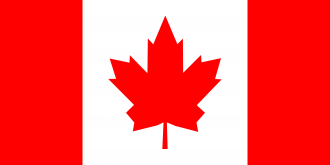The country experienced a solid economic growth from 1993 through 2007, a trend that was averted in the final months of 2008, due to the global economic recession. The robust and well-function socio-economic environment of Canada helped the country to quickly upend this negative development as real Gross Domestic Product (GDP) increased 1.2% in the fourth quarter of 2009, the largest quarterly increase since the third quarter of 2000. Since then, the Canadian economy recorded a stable but moderate growth, averaging some 2.1% per year over the period 2011-2015. In the second quarter of 2016, the economic growth of Canada was somehow deterred, as GDP decreased by 0.4%, after increasing 0.6% in the first quarter. This was the largest decline in quarterly GDP, since the second quarter of 2009. Nevertheless, it should be noted that excluding the crude petroleum output, real GDP actually grew by 0.1%. The economic growth of Canada has been inclusive, a fact that is highlighted by the significant increase recorded in the country’s GDP per Capita, which is one of the biggest in the world. In the fourth quarter of 2016, it reached 56,737 Canadian dollars (CAD) significantly increased when compared to the 2011 level of 51,537 CAD.
Education, health, social and government services contributed on average 20.5% of the GDP for the period 2011-Q4 2016, while finance insurance and real estate services contributed on average 19.4% clearly indicating that the Canadian economy is service oriented. On the other hand, agriculture, forestry, fishing and hunting contributed 1.6% on average over the period, being the sector contributing the least to the national GDP.
On the other hand, the unemployment rate remained unchanged at 7%, as of October 2016. Demographic wise, unemployment rate among young people, aged 15-24, remained unchanged at 13%, among men aged 25 to 54 the respective rate was 6.4%, while for women of the same demographic group unemployment slightly decreased (by 0.4%), to 5.3%.
Canada is considered to be a center of global innovation. Several companies from around the world, in manufacturing sectors such as aerospace, choose to perform many of their manufacturing, as well as Research and Development (R&D) activities, in Canada. Historically, the country spends a fair amount of money on R&D. It is indicative that in 2015, 1.59% of the country’s GDP was spent on R&D activities. Highlighting the importance of innovation for the Canadian society, according to the 2016 budget, some 2 billion CAD over three years, starting from 2016–17, were to be provided for a new Post-Secondary Institutions Strategic Investment Fund and an equivalent amount for establishing the Low Carbon Economy Fund over a period of 2 years (starting from 2017-2018). Additionally, the budget for 2016, proposed the allocation of 197.1 billion CAD, over a five year period, to Fisheries and Oceans Canada to increase ocean and freshwater science monitoring and research activities.
Canada is one of the largest export economies in the world. In 2015, Canada’s total exports (goods & services) reached 627.2 billion CAD, while imports reached 674.7 billion CAD resulting in a negative trade balance of 47.5 billion CAD. The top export destinations of Canada in 2015, were the United States (76.7% of total exports), China (3.8% of total exports), the United Kingdom (3% of total exports), Japan (1.9% of total exports) and Mexico (1.3% of total exports). On the other hand, the five major supplying nations based on the 2015 imports to Canada, were the United States (53.2% of total imports), China (12.2% of total imports), Mexico (5.8% of total imports), Germany (3.2% of total imports) and Japan (2.8% of total imports).
In the second quarter of 2016, exports dropped by 4.5%, following a 1.9% increase in the first quarter. This was the largest decline in exports since the first quarter of 2009. On the other side, imports rose by 0.3%, following a 0.4% increase in the first quarter of 2016. More specifically in the 4th quarter of 2016, exports reached 163.5 and imports 168.2 billion CAD. The US was once again the most important trade partner of Canada for the same quarter, being the recipient of 76.4% of the country’s total exports, while on the other hand being the origin of 52.2% of total imports.

